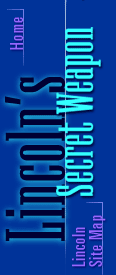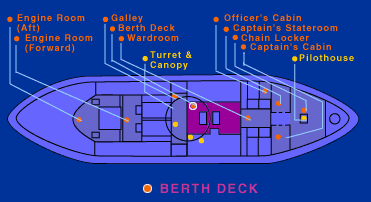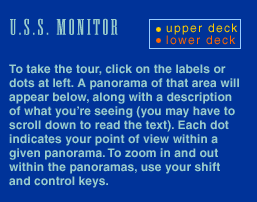 |

|

|
 |
|
Intro |
Galley |
Deck |
Canopy |
Wardroom |
Officer's Cabin |
Captain's Cabin |
Captain's Stateroom |
Turret |
Pilothouse |
Chain Locker |
Berth Deck |
Engine Room - Forward |
Engine Room - Aft Berth Deck Just forward of the midships structural bulkhead, which divided the Monitor into two sections, lay the berth deck. An open area beneath the turret that was about 27 feet long by 18 feet wide, the berth deck housed the 48 enlisted men and a few of the unlucky junior officers. The Navy preferred to have the enlisted men sleep in hammocks that were hung from ash poles inserted into sockets in the wooden deck overhead, but few did. One crewman who was on board from the day the ship left New York until the night the vessel sank claimed that he had only slung his hammock twice in his entire time onboard the Monitor. Like most of the men, he simply spread his hammock on the hard deck. The berth deck was crowded and offered virtually no privacy, because anyone moving between the ship's bow and stern sections had to pass through this area. Ladders led from the berth deck up into the turret and onto the deck through the officer's hatch, so there was little peace and quiet either. All lighting on the berth deck was artificial, and the walls were painted white to help reflect the lanterns' flickering glow. The berth deck also housed the magazine and shell rooms. The powder magazine lay on the starboard side of the ship, just forward of the midships bulkhead. It was a nine-by-nine-foot room walled in iron and lined on the inside with lead to prevent any chance of sparks. Here the crew stored 'loose' powder, for both cartridges and exploding shells, in specially designed copper tanks that were contoured to fit the shelves along the walls. They kept a small number of 'fixed' cartridges filled and ready for use. To preclude any chance of an accidental explosion in the magazine, Ericsson incorporated several safety features into the design. Attached to the outside of the magazine was a light room, where illumination from an oil lamp spilled into the magazine through a thick glass porthole. The magazine's entrance was set off in a type of foyer and secured with a heavy iron door. During action, when the crew left the door ajar, a thick canvas curtain covered the entrance. In case of a fire below decks, crew members could flood the compartment by opening a sea-cock. The iron-walled shell room stood on the port side across from the magazine. Here, in a 72-square-foot space, the crew stored exploding projectiles, fuses, and cannon primers. Non-exploding cannonballs lay stacked at the aft end of the berth deck as well as in racks in the turret. Storage closets and pantries took up the remainder of the outboard areas of the berth deck, while a limited amount of storage space beneath it served as the Monitor's hold. Tour the Monitor | Behind the Scenes Eyewitness to the Battle | Steam Machine | Resources Transcript | Site Map | Lincoln's Secret Weapon Home Previous Sites | Adventures | Join Us/E-mail | TV/Web Schedule Teachers | Site Map | Search | Shop | To print PBS Online | NOVA Online | WGBH © | Updated October 2000 |
||